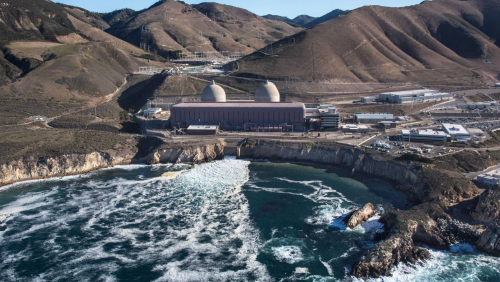The Future of Nuclear Power
November 15, 2022 by Alex Sugg

A bird’s eye view of the Diablo Canyon Nuclear Power Plant with the blue waves of the Pacific Ocean seen crashing on rocks in the foreground, brown rolling hills and a blue sky are seen in the background.
Congress just passed the Inflation Reduction Act (IRA) and the CHIPS and Science Act (CHIPS).[1] These bills provide for forward looking investments in nuclear energy. The IRA lists nuclear energy as a possible recipient of the $369 billion that it sets aside for clean energy.[2] The IRA also provides a $15-to-$25 per megawatt-hour credit for pre-existing nuclear power plants.[3]
This spells good things for older nuclear plants that support some of our nation’s less-stable energy grids. The Diablo Canyon Nuclear Plant in San Louis Obispo, California is potentially one of those plants. Diablo has recently been given an extended life until 2030 instead of the originally-planned 2025 shutdown date.[4] Diablo is currently 37 years old and was given this extension, urged by Governor Gavin Newsom, to try and stabilize California’s power grid in the face of the growing risk of rolling blackouts.[5]
Diablo Canyon provides 9 percent of California’s total electricity and 15 percent of its carbon-free energy.[6] The need for Diablo’s extended life became apparent as record temperatures stress alternative clean energy sources, due to heat lingering longer into the night and compelling greater electricity use for air conditioning.[7]
Alongside the IRA’s support for our aging nuclear power plants like Diablo Canyon, the IRA and CHIPS Act provide funding for more advanced, smaller, more efficient, and more affordable reactors.[8] In the CHIPS Act, a provision entitled Fission for the Future explicitly sets aside $800 million to go towards the commercial planning, licensing, and development of these more advanced reactors, prioritizing communities that host older fossil fuel generation facilities.[9] Such prioritization could help revitalize or at least preserve these older coal communities.
These recent bills supporting nuclear power could be only the beginning of a trend in this country. Gallup has tracked trends of public opinion toward nuclear energy since 1994, attributing times of strong support for nuclear energy to high oil and gas pump prices.[10] The trend shows increasing support since 2016 and as the war in Ukraine continues to destabilize gas prices that trend seems likely to continue.[11]
Though we are still waiting for the election results from the November 8th midterms, nuclear power does seem to have at least some bipartisan support, with “39% of Democrats” – including President Biden – “60 % of Republicans and 53% of independents favor[ing] nuclear energy.”[12] Therefore, regardless of which party gains control of the House of Representatives, the trend of rising support for nuclear power in Congress, through provisions similar to those included in the CHIPS Act and the IRA, and amongst the public seems likely to continue.
[1] Theodore “Ted” Garrish, The IRA and CHIPS Act were great for Nuclear energy – here’s what we should do next, The Hill (Oct. 13, 2022, 1:30 PM), https://thehill.com/opinion/energy-environment/3686639-the-ira-and-chips-act-were-great-for-nuclear-energy-heres-what-we-should-do-next/.
[2] Id.
[3] Id.
[4] Dale Kasler, PG&E formally moves to extend life of Diablo Canyon, the last nuclear plant in California, The Sacramento Bee (Nov. 1, 2022, 11:52 AM), https://www.sacbee.com/news/politics-government/capitol-alert/article268116547.html.
[5] Id.
[6] Garrish, supra note 2 (statistics from 2021).
[7] Id.
[8] Id.
[9] Id.
[10] Lydia Saad, Americans divided on Nuclear Energy, Gallup (May 20, 2022), https://news.gallup.com/poll/392831/americans-divided-nuclear-energy.aspx.
[11] Id.
[12] Id.

